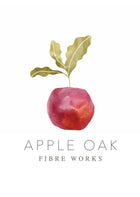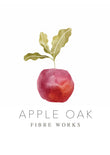
Ready to dive into natural dyeing? Welcome to The Apothecary! Here you'll find our line of natural dyes, mordants, and tools to get you started on your dyeing journey.
8 products









Madder Dye – Cut or Ground
Rich Natural Reds for Dyeing | Wild-Harvested in Eastern Europe
Madder (Rubia tinctorum) is a renowned natural dye that produces a stunning range of reds—from warm oranges and rich brick reds to deep blood reds and fiery crimson tones. The final shade depends on multiple factors, including soil conditions, root age, mineral content of the water, dyeing temperature, and fibre-to-dye ratio.
Dyeing Tips:
Colour Fastness: Excellent – Madder is known for its durability and deep, lasting hues.
Discover the beauty of natural dyeing with madder and create your own unique reds!
------------
Recipe for Wool: Downloadable PDF
Recipe for Plant fibres: Downloadable PDF
Also available as dye kit!
Madder Dye Kit for Plant Fibers: Available Here »
Madder Dye Kit for wool & Silk: Available Here »
(Adjust quantities as needed to achieve your desired shade. Water quality will influence colour result. Oranges instead of reds are often more likely)
IMPORTANT: The higher the temperature, the darker and browner the final shade.
Join The Natural Dyers & Growers Academy to share your experiences and get support from fellow growers.
OAK GALL
Use: Cellulose Fibre Mordant | Harvested From: Aleppo Oak in Turkey | Also Known As: Oak Apple | Recipe: link below
Oak Gall, also known as Oak Apple, is harvested from the Aleppo Oak in Turkey and is a traditional mordant used for cellulose fibres. Due to its high tannin content, it is an effective mordant for preparing cellulose-based fabrics for natural dyeing. Unlike other tannin-based mordants, Oak Gall only stains the cellulose fibre a light beige, making it a preferred choice for delicate dyeing projects.
Key Features:
Function:
Oak Gall is used to prepare cellulose fibres for natural dyeing, helping the dye adhere to the fabric without leaving stains. Its high tannin content ensures vibrant and durable colours on cellulose fabrics like cotton, linen, and hemp.
Storage & Usage:
Perfect for natural dyers and textile artists working with cellulose fibre. Please see this recipe for mordanting cellulose with Gallotannin
100 % Natural Indigo | Origin: India | No synthetic additives
Harvested and processed in southern India, this true indigo powder delivers the deep, cool blues prized by dyers for centuries. Because indigo is an insoluble pigment (not a dye that bonds with a mordant), no mordant is required—just a reduced (oxygen-free) vat.
Why choose our indigo?
• Authentic & plant-based – Derived solely from Indigofera tinctoria leaves; never synthetic.
• Economical – ≈ 50 g colours 3–4 kg of wool to a strong mid-blue.
• Low-energy process – Vats work at 30 – 40 °C; no hard boiling.
• Versatile methods – Suitable for any indigo vat, be it fructose, mineral or bran-ferment vats, yeast vats, sig vats or quick hydros vats.
• Excellent colour-fastness – Outstanding on deeper shades, good on lighter blues.
Typical yield
• Pale sky blue – 1 g per 100 g fibre
• Medium denim – 5 g per 100 g fibre
• Deep navy – 12 g + per 100 g fibre (multiple dips)
Quick-start options
• Organic Sugar Vat – Indigo + lime + fructose (no fermentation wait).
• Yeast Fermentation Vat – Gentle, long-lasting; see recipe below.
• Hydros Vat – Fast one-hour reduction (includes chemical oxygen remover).
Yeast Vat Recipe (500 g fibre)
9 l water · 110 g sugar · 50 g preservative-free dried yeast
30 g bicarbonate of soda · 40 g indigo (ground)
• Maintain 40 °C (not above 50 °C).
• Reduce for 48 h until liquid turns yellow-green with a copper sheen.
• Dip pre-wetted, unmordanted fibre; oxidise 60 min; repeat for depth.
Storage & safety
Store in a cool, dry place, sealed against moisture. Wear a mask when handling fine pigment and gloves when working with lime, hydros or iron additives. Dispose of spent vats responsibly.
Looking for a complete setup? Our Indigo Sugar Vat Kit and Hydros Vat Kit include all auxiliaries, plus step-by-step instructions.
Logwood Dye
Dye Colour: Blue, Purple & Black | Collected in the Wild in Haiti
Logwood (Haematoxylum campechianum), also known as Bois de Campeche or Campeachy Wood, is a natural, pH-sensitive dye that originates from wood found in Central America. This versatile dye creates stunning blues, purples, and deep blacks on wool, cotton, and silk. While its colour fastness is considered poor by experienced dyers, Logwood is commonly used in combination with other dyes to achieve rich, deep blacks. Perfect for eco-conscious artists, Logwood is available as cut or ground bark for your dyeing projects.
Colour Fastness: Poor (best used with other dyes for black)
Product Details:
Basic Recipe (Using Ground Bark):
Ingredients:
Instructions:
Alternatively, soak the Logwood chips overnight, then boil for 1 hour before use.
For Logwood extract, please visit our Natural Dye Extracts Page.
Explore the potential of Logwood Dye for a range of vibrant blues, purples, and blacks in your natural dyeing projects!
Organic Ground, Cut, or Whole Hibiscus Flowers
Vibrant Pink & Purple Hues for Dyeing | Cultivated in Egypt
Hibiscus flowers are an excellent choice for natural dyeing, offering stunning shades from light purples to deep pinks and even greens, depending on the mordant used. Ground Hibiscus produces a lighter purple hue on wool, while cut or whole flowers yield more vibrant tones. This pH-sensitive dye is perfect for hobby dyers and children’s activities, as it offers interesting colour shifts - from green to purple to pink - and an experimental approach to dyeing.
Dyeing Tips:
Colour Fastness: Poor (colour may shift with pH changes)
Basic Hibiscus Dye Recipe:
A delightful and experimental natural dye, perfect for adding beautiful, ever-changing shades to your projects!
Join The Natural Dyers & Growers Academy to share your experiences and get support from fellow growers.
RHUBARB ROOT GROUND ONLY
Dye Colour: Yellow Brown, Green (with Iron), Pink (with Soda Ash) – pH and Mordant Dependent | Country of Collection: China
Rhubarb root is a captivating natural dye, producing a spectrum of colours that vary depending on the pH of the dye bath and the mordant used. Known as a Quinone dye, it is rich in tannins, which yield earthy yellow-brown and green hues with iron. A higher pH will shift the colour to delicate pinks or reds, though these tones are less colourfast. Notably, the yellow and green shades are more stable, maintaining their colour for longer.
Colour Fastness:
pH Sensitivity: High pH will shift the colour to red.
Colour Outcomes by WOF Ratio & pH/Mordant:
Basic Recipe for Wool:
Instructions:
Explore the versatility of Rhubarb Root as a natural dye and unlock a range of rich, pH-dependent colours in your yarn and fabric projects!
TARA POWDER ~ is a natural tanning product
Grown in the mountains of Peru.
Tara powder will stain the fibres grey and it is recommended to use a strong dye so the colour isn't too influenced. I am using it for plant dyed flax fibres and LinCot yarns and found, that it actually adds some more depth to the colour.
Basic Recipe:
Please see our blog post on How to mordant linen and cotton fabrics successfully – AppleOak FibreWorks
Please note: cut root bark is currently out of stock but will be restocked soon.
Barberry Root Bark – Ground & Cut
Source: Berberis spp. (Barberry)
Barberry root bark is a traditional dye material valued for its high content of berberine, a potent plant alkaloid that yields clear, brilliant yellows on protein fibres. When modified with iron, it shifts to olive greens, making it a versatile addition to any natural dyer’s toolkit.
This listing includes ground root bark for quick extraction and cut bark for longer decoctions or soaking methods.
Barberry is known for its excellent light fastness, especially on wool and silk.
Main Components:
Berberine (alkaloid)
Alkaloid-rich tannins
Suggested Quantities (WOF):
20–30% for clear yellow
With iron: 25–40% for olive tones
Simmer gently for 60 minutes
Uses:
Brilliant yellow dyeing on wool and silk
Olive green shades with iron
Layered plant dyeing with tannins and modifiers
Historical dyeing and pigment preparation
The Plant: Barberry is a spiny shrub found across Europe and Asia. The root bark is its most dye-rich part, containing vibrant yellow berberine compounds also used in traditional medicine and inks.
Light Fastness:
High (excellent retention on protein fibres)
Form:
Ground and cut root bark
Tips:
Try layering with tannins like oak gall or sumac to deepen tone. Use on its own for luminous yellows, or with iron sulfate for olive greens.
Join The Natural Dyers & Growers Academy to share your experiences and get support from fellow growers.
We’re not fans of crowded inboxes either, so here’s what you can look forward to in our newsletters:
✨ Updates from the Academy – new workshops, courses, and events
🧶 News from the Dye House – behind-the-scenes, fibre stories, and inspiration
🛍 Shop highlights – fresh arrivals, special offers, and exclusive sales
And of course, you’re always in control — unsubscribe anytime with a single click at the bottom of any email.
As a little welcome gift, enjoy 5% off your first order in our webshop with the code WELCOMEPOP.
Happy making! 🌿

